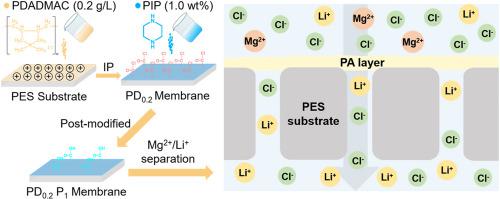当前位置:
X-MOL 学术
›
J. Membr. Sci.
›
论文详情
Our official English website, www.x-mol.net, welcomes your
feedback! (Note: you will need to create a separate account there.)
Enhancing Mg2+/Li+ separation performance of nanofiltration membranes through polyelectrolyte modulation and surface modification
Journal of Membrane Science ( IF 8.4 ) Pub Date : 2024-04-05 , DOI: 10.1016/j.memsci.2024.122725 Jingjun Wang , Hao Zhang , Rukang Tian , Huiyan Shen , Wei-Hua Li , Yunkun Wang
Journal of Membrane Science ( IF 8.4 ) Pub Date : 2024-04-05 , DOI: 10.1016/j.memsci.2024.122725 Jingjun Wang , Hao Zhang , Rukang Tian , Huiyan Shen , Wei-Hua Li , Yunkun Wang

|
The increasing demand for lithium resources in the rapidly growing new energy industry has spurred interest in efficient lithium extraction from salt-lakes using Nanofiltration membranes, owing to their impressive ionic rejection capabilities. However, achieving effective Mg/Li selective separation remains a critical challenge for the widespread application of NF membranes in lithium extraction. This study focuses on the utilization of poly(dimethyldiallylammonium chloride)-modified polyethersulfone substrate for interfacial polymerization modulation in the preparation of polyamide nanofiltration membrane. The prepared membrane exhibited high MgCl rejection. And then the prepared membrane was subsequently optimized by post-modification with piperazine. Previous and subsequent modifications resulted in smaller pores, narrower pore size distribution, and lower surface negativity of the modified membrane. These properties contributed to the significantly higher MgCl rejection rate of the modified membrane (94.7%) than that of the Control membrane (46.1%). This excellent rejection property ensured the efficient Mg/Li separation performance of the modified membrane. It was noteworthy that the Mg/Li separation factor for lithium extraction in simulated brine reached an impressive 77.2. In addition, the modified membrane retained a comparable pure water permeance and NaSO rejection rate as the control membrane and showed excellent stability, significantly improving the Mg/Li separation efficiency while reducing energy consumption. This study presents a simple strategy to fabricate NF membranes with excellent Mg/Li separation factor.
中文翻译:

通过聚电解质调节和表面改性增强纳滤膜的Mg2+/Li+分离性能
快速发展的新能源行业对锂资源的需求不断增加,激发了人们对使用纳滤膜从盐湖中高效提取锂的兴趣,因为纳滤膜具有令人印象深刻的离子截留能力。然而,实现有效的镁/锂选择性分离仍然是纳滤膜在锂提取中广泛应用的关键挑战。本研究重点研究了利用聚二甲基二烯丙基氯化铵改性聚醚砜基材进行界面聚合调节来制备聚酰胺纳滤膜。制备的膜表现出较高的 MgCl 截留率。然后通过哌嗪后修饰对制备的膜进行优化。先前和随后的修饰导致修饰膜的孔径更小、孔径分布更窄、表面负性更低。这些特性使得改性膜的 MgCl 截留率 (94.7%) 明显高于对照膜 (46.1%)。这种优异的截留性能保证了改性膜高效的镁/锂分离性能。值得注意的是,模拟盐水中提取锂的镁/锂分离因子达到了令人印象深刻的 77.2。此外,改性膜保留了与对照膜相当的纯水渗透率和NaSO截留率,并表现出优异的稳定性,显着提高了镁/锂分离效率,同时降低了能耗。这项研究提出了一种简单的策略来制造具有优异镁/锂分离因子的纳滤膜。
更新日期:2024-04-05
中文翻译:

通过聚电解质调节和表面改性增强纳滤膜的Mg2+/Li+分离性能
快速发展的新能源行业对锂资源的需求不断增加,激发了人们对使用纳滤膜从盐湖中高效提取锂的兴趣,因为纳滤膜具有令人印象深刻的离子截留能力。然而,实现有效的镁/锂选择性分离仍然是纳滤膜在锂提取中广泛应用的关键挑战。本研究重点研究了利用聚二甲基二烯丙基氯化铵改性聚醚砜基材进行界面聚合调节来制备聚酰胺纳滤膜。制备的膜表现出较高的 MgCl 截留率。然后通过哌嗪后修饰对制备的膜进行优化。先前和随后的修饰导致修饰膜的孔径更小、孔径分布更窄、表面负性更低。这些特性使得改性膜的 MgCl 截留率 (94.7%) 明显高于对照膜 (46.1%)。这种优异的截留性能保证了改性膜高效的镁/锂分离性能。值得注意的是,模拟盐水中提取锂的镁/锂分离因子达到了令人印象深刻的 77.2。此外,改性膜保留了与对照膜相当的纯水渗透率和NaSO截留率,并表现出优异的稳定性,显着提高了镁/锂分离效率,同时降低了能耗。这项研究提出了一种简单的策略来制造具有优异镁/锂分离因子的纳滤膜。


















































 京公网安备 11010802027423号
京公网安备 11010802027423号